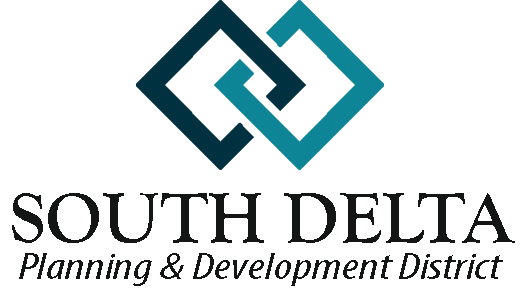Summary Background
SUMMARY BACKGROUND
South Delta Planning and Development District includes 41 units of local government. Six counties and thirty-five municipalities make up that number. The counties served by the Planning and Development District are Bolivar, Humphreys, Issaquena, Sharkey, Sunflower and Washington. The regional analysis section of this document serves to give insight into the traits and characteristics that make up the area known as South Delta. Population and demographics, clusters, infrastructure, financial resources and external forces will be looked at from a regional standpoint as well as on a county-by-county basis.

Total Population
116,399
South Delta PDD

Unemployment Rate
4.2%
South Delta PDD

High School Graduate or Higher
79.06%
South Delta PDD

Civilian Labor Force
45,315
South Delta PDD
POPULATION
South Delta is comprised of 3,602 square miles of land area. That equates to approximately 8% of Mississippi’s land area. Based on U. S. Census Bureau 2020 Population figures, there are 118,263 people living in the South Delta region. This is only 3.8% of the 2020 Mississippi population. The population of the District and the State of Mississippi, between 2010 and 2020, decreased by 11.98% and .20% respectively. Until 2020 the State had consistently shown an increase in population. The district, however, has had an average decrease in population of 9.58% at every Census since 1960. The 2010 Census showed a District population decrease of 17.5%, the largest decline since the 1960 Census.
South Delta Planning and Development District experienced a total population decline of 44.75% from 1960 to 2020. The majority of the district’s population resides in three of the six counties. These three counties – Bolivar, Sunflower and Washington – have over 88.74% of the population. Going hand in hand with this is the fact that the majority of the civilian labor force resides in and is employed in these three counties. Residents of the three smaller counties, the three southern counties of the district, must obtain employment from the limited opportunities in each county. Those unable to find employment within their own county must commute to the surrounding areas.
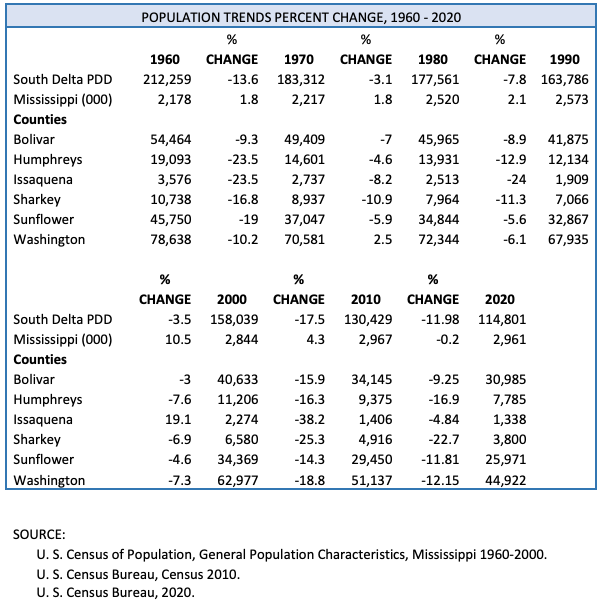
Generally, it can be stated that there are certain prevalent population, labor force, income and educational trends in the South Delta District that have existed throughout the last 60 years and are still present in varying and/or worsening degrees today. In the past, the district’s economy was based almost solely on agriculture. With the advent of mechanized farming, the need for laborers who possessed very little education and few job skills diminished drastically. Laborers were forced to seek employment elsewhere, usually in the industrialized cities of the North. In 2022, just as in 2012 and 2017, the district can be described as a persistently distressed area experiencing a continuing decline in population due to out-migration and death; unemployment rates that are high; median family incomes that are extremely low; numbers of persons living below the poverty level are high and educational levels that are below standard.
The population of the district has declined by approximately 97,458 persons between 1960 and 2020. While all counties in the district have experienced significant population losses during the past several decades, Sharkey County has experienced the greatest loss in percentage of population. Sharkey County lost 64.61% of its population during the period 1960-2020, while Issaquena County followed closely with a population of loss of 62.58%. In terms of absolute numbers, Washington County lost the greatest amount of population during the same period amounting to over 33,000 persons.
A decreasing population is currently the most concerning threat to the South Delta area. The decline in population was previously considered to be mostly a product of outmigration, “brain drain”. Now the long-term impacts of “brain drain/outmigration” are truly becoming apparent. During the period from 1990-99 there were 26,767 births in the district. Between 2010 and 2017 the number of births in the district had decreased by 51.5% to 12,981. In the period of 2017 through 2021 births had dropped to 7,332. The number of deaths in the district,10,557, during the same period, 2010 – 2017, resulted in a natural increase of 2,424. Despite the fact that births in the district outnumbered deaths, overall population continued to decline. Now during the period of 2017 through 2021 deaths, 8,437, outpaced births accelerating the rate of population decline. Out migration/brain drain, although no longer the major contributing factor of population decline, remains a concern for the region.
Based on the 2016 U. S. Census American Community Survey Data, the District’s median age was 36 years while Mississippi’s was 36.7 and the United States’ 37.7. According to the 2020 U. S. Census American Community Survey, the District’s median age increased to 38.7 years while Mississippi’s increased to 37.7 and the United States to 38.2. The district’s median age in 1960 was 19.9 years indicating the district’s population is continuing to age. Of the district’s population in 2016, 35.8% were 0-24 years old while 13.4% were 65 years of age or older. This left 50.8% of the district’s population in the productive working age group of 25-64. As the overall population of the region has declined these numbers have shifted slightly. In 2020 34.26% of the population was in the age range of 0-24 and 15.86% were over the age of 65. This has left 49.88% of the population in the productive working age range.
The fact that there is no major shift in any one of these segments of the population gives the impression that outmigration/brain drain is still the major contributing factor to the overall population decline. There will be no drastic upward changes in population unless there are significant changes in economic conditions and the perception of these conditions.
Until opportunities and quality of place improve, the steady out-migration of population will continue. Therefore, efforts must be placed on retaining and attracting population to the area. The “brain drain” must be addressed. Arresting the “brain drain” and drawing younger, educated individuals either back to the area or to it for the first time always brings about the age old “chicken and egg” conundrum. Which comes first? Do you focus on recruiting industry with the idea that younger people will come to the jobs? Do you focus on attracting the younger people in the hopes that industries will choose to locate where the bright, young, well-educated work force is located? Unfortunately, people can’t live on good intentions and growing an area out of nothing. The industry side of this equation should come first but with an initial focus on industry that can utilize a somewhat transient work force until locals are trained and additional population is attracted to the area. The trend of out-migration, especially among the college aged/young adult groups, cannot continue. Everything else that leads to a turnaround in the fortunes and livability of the district depends on having a younger, educated and energetic population in the area.
INCOME
The average 2019 median household income of the district is $28,826, a $544 improvement from 2016, while that of the State improved from $40,528 to $45,081 and the Nation, according to the 2020 ACS is $64,994. The district’s average median household income remains significantly lower than the State’s and Nation’s. Based on the 2021 American Community Survey 5 Year Estimates, 15% of the 40 reporting units of local government in the South Delta area had a median household income of less than $20,000 and 67.5% had a median household income of less than $30,000. Economically, the District continues to lag, significantly, behind the State and Nation. The percentage of households in Mississippi and the United States with an annual household income of $10,000 or less is 9.3% and 5.8% respectively; whereas, the percentage in the South Delta region is 18.34.
Transfer payments continue to make up a large share of personal income for all South Delta counties. Three of the counties in the South Delta area are among the counties with the highest percentage of transfer payments as a component of personal income in the state, Issaquena has the highest in the state, 61.2%, the regional average is 44.3% up from 37.7% in the previous CEDS. These percentages are well over Mississippi’s percentage of 26.2. Transfer payments are government payments to individuals that are not paid in return for goods and services to the government. Examples include social security, unemployment compensation and welfare payments.

In 2016 36.1% of South Delta’s citizens were living below the poverty level. In 2017 that percentage had decreased slightly to 35.6%. Although slightly improved, the percentage of persons living below the poverty is still over twice the national percentage. The segment of the population with the highest percentage below the poverty level is family households with a female head of household.
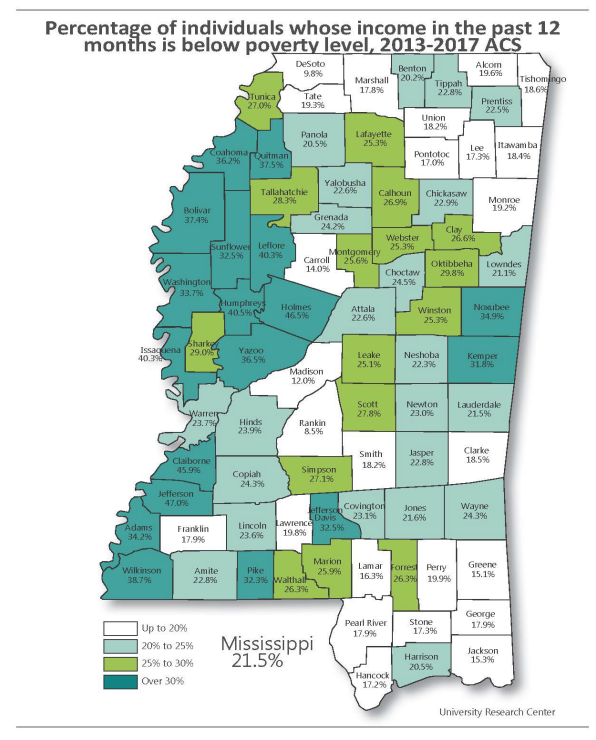
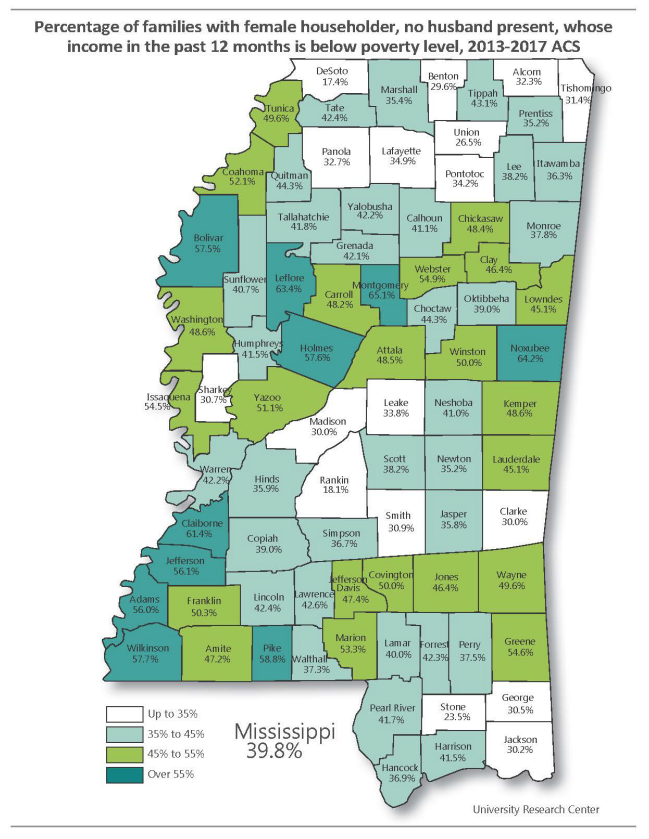
EDUCATION
The educational attainment level within the district had improved slightly between 2010 and 2016; however, according to the 2015-1019 ACS the average percentage of the district’s total population above 25 years of age that had completed high school or above had dipped to 73.23%, compared to 84.5% for the State. These numbers still reflect a considerable improvement in Education levels in the district since 2000, from a 50.7% high school completion percentage to 73.23%. These improvements are encouraging, but there is still much to be done in order for the South Delta region to compete in the State, the Nation, and the World.
With regard to income and education, these two factors must be one of the major focal points for improvement of the region. All other man-based factors are dependent on these things for improvement. The improved focus on workforce training and vocational education rather than the concept of the only way to a good job is through a college degree will continue to help make the region more competitive in attracting skilled employment opportunities.
EMPLOYMENT & LABOR FORCE
The district’s labor force steadily declined from 66,811 in 1960 to 57,565 in 1970, rebounded in 1980 to 60,865 continued upward in 1990 to 64,030 and has fallen drastically to 55,624 in 2010 and even farther to 35,910 in January, 2023, according to the Mississippi Department of Employment Security. The 2017 district labor force was 42,720 of which 39,548 were employed. The June 2018 District labor force, according to the Mississippi Department of Employment Security, was 43,000 of which 39,460 were employed. The January, 2023 labor force number was 35,910 of which 34,060 were employed. The unemployment rate for the period was 5.2%. The January, 2023 unemployment rate gives the appearance that things are improving by showing that there is a larger percentage of the labor force employed and that the region is not as far behind the state and nation as seen previously. However, that is a higher percentage of a much smaller number of labor force participants.
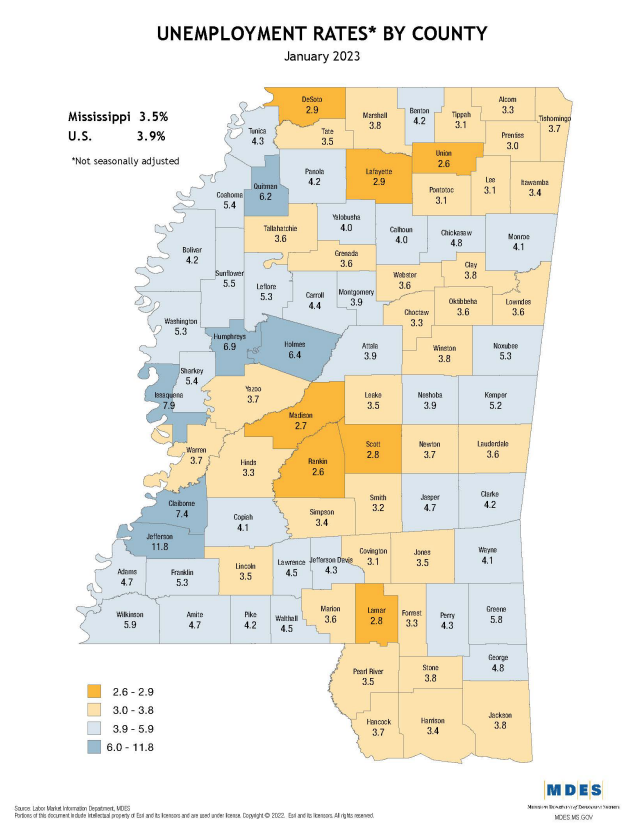
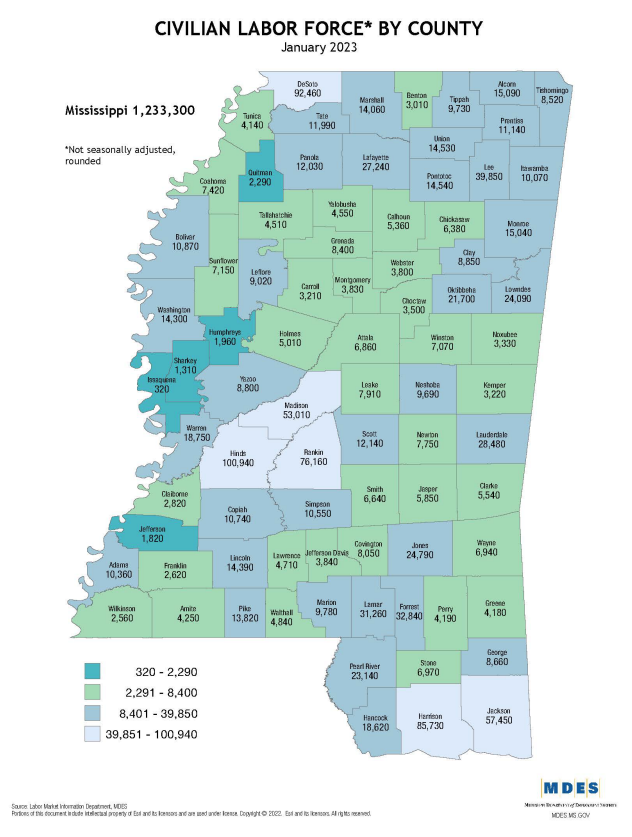
At one time the major draw for companies to come to the Delta was a large labor pool that would work for low wages. That is no longer the case. Out migration and lower labor force participation rates have reflected a change in the attitude of the area’s labor pool. Many of the working age population are no longer willing to remain in situations of underemployment and have chosen to take steps to improve their situation by moving to areas with better opportunities or leaving the labor pool altogether.
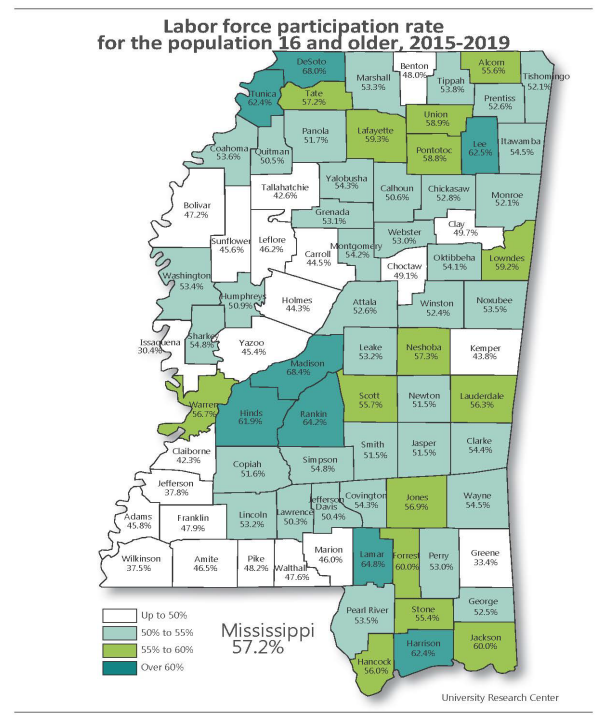
In an effort to bring better, higher paying job opportunities to the area, the ACT WorkKeys National Career Readiness Certificate program was implemented throughout the 6 South Delta counties as well as the surrounding 8 workforce counties. This program put the labor pool on an equal footing with the entire nation. Employers could no longer look to the Mississippi Delta for a plentiful and cheap labor pool. The most recent ACT Certificate numbers are proof that when it comes to a useful, trainable workforce, the region can hold its own.
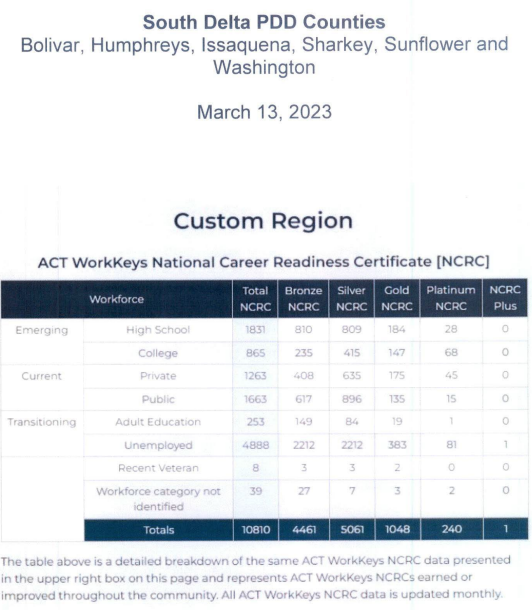
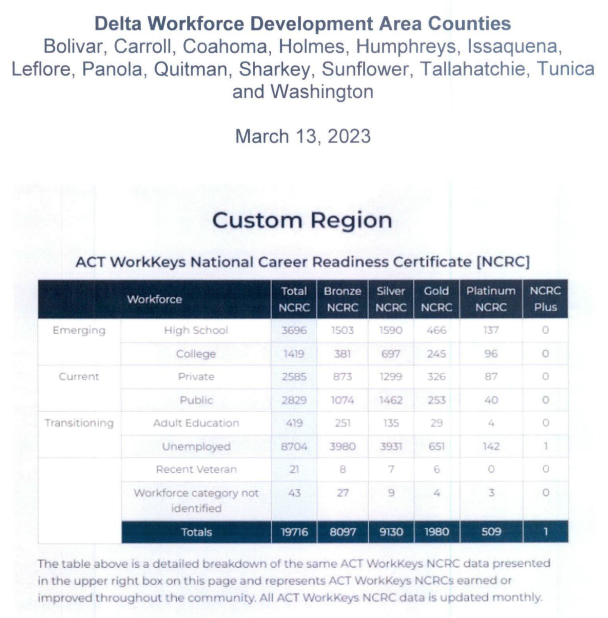
As noted in the previous tables indicating the number of people in the region with ACT NCRC certificates, the single highest category in each table is the Silver Certificate. This means that the majority of the Delta workforce can perform at a skill level equal to a silver certificate holder any where else in the country. The region no longer has to rely on the industries that need high volume, low income/low brainpower to bring employment to the area. Industrial recruitment can now focus on companies that need more skill and trainability. Recruitment of these types of industries can be a huge help in arresting and reversing the outmigration trend.
One component of this is a workforce that improves and advances with time and technology. To this end the district is the fiscal agent for the Delta Workforce Development Board (DWDB). It provides the administrative functions associated with the Workforce Innovation and Opportunity Act (WIOA). Six South Delta staff members currently provide support to the Board and coordinate workforce programs and activities in the 14-county workforce area.
In accordance with the Workforce Innovation and Opportunity Act, it is the purpose of the Delta Workforce Development Board to provide workforce activities in the local area that 21 will increase the employment, retention and earnings of participants and increase occupational skills attainment by participants, and, as a result, improve the quality of the workforce, reduce welfare dependency and enhance the productivity and competitiveness of the fourteen counties which constitute the Delta Workforce Development Area (DWDA).
In FY’07, the DWDA was awarded $10 million to serve DWDA eligible adults, dislocated workers and youth, since then the awards have steadily decreased, yet the need continues to increase as the Region, State and Nation fall farther behind the rest of the world in the ultracompetitive global market. Seven WIN Job Centers (one-stop operators) in the 14 counties provide adult and dislocated worker services. The DWDA focuses a lot of activity on economic development to recruit new businesses and retain existing businesses through On-the-Job Training and Customized Training. DWDA eligible participants are provided services through Individual Training Accounts to help them get a first job or a better job.
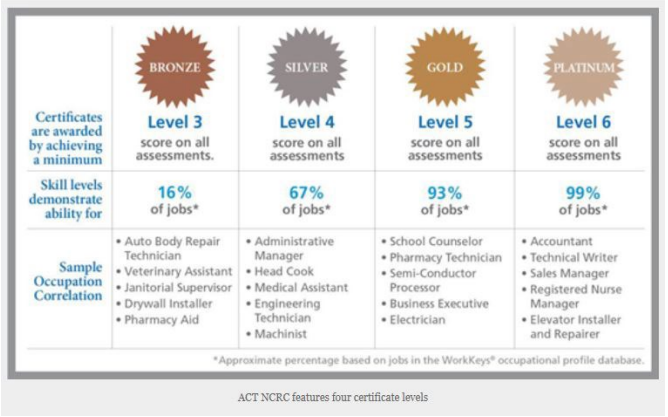
New efforts are underway in the DWDA to focus on sector training initiatives to address local needs. The DWDA will be exploring specific job sectors and will allocate a certain amount of funds to that specific sector. Some areas to be considered include electrical linemen, A & P (aircraft maintenance), health care, hospitality and advanced manufacturing.
These sector initiatives will focus on key industries, promote education and training, provide opportunities for career advancement and create new jobs while building the area’s skilled workforce. These efforts will also help create shared objectives and priorities between public and private partners to leverage new and existing resources.
HOUSING
Housing characteristics in the South Delta region are directly related to the environment of the population. One of the negative housing characteristics in the area, as well as in the State, is the age of housing. Of the 52,162 housing units in the six-county area 11.71% were constructed prior to 1949 and only .63% were constructed between 2014 and 2018. The majority of the housing stock in the region was constructed between 1950 and 1999. The very small percentage of new construction indicates that the current housing stock 25 will age and deteriorate. Substandard housing units will become a bigger issue as the majority of the existing housing stock reaches the upper limits of usefulness. The percentage of housing units in the region lacking complete plumbing and/or kitchen facilities is slightly less than that of the state, .78% and 1.1% respectively. This is an indicator that some efforts are being made to improve the existing housing stock. The fact remains that these aging housing units will become more difficult to address as the numbers increase. It is also an unfortunate by-product of population loss, as well as, the regional and national economy that there is very little housing construction taking place.
According to the 2014 – 2018 American Community Survey conducted by the U. S. Census Bureau there are 19,872 renters in the South Delta area. This reflects a slight increase in renters from the 2012 – 2016 American Community Survey. Some studies have shown a need and desire among renters to become homeowners; however, financing for lowand moderate-income families is often difficult or even impossible to obtain. Experience has shown that not everyone with a desire to own a home is capable of doing so. South Delta has, when programs were available, attempted to address this need through some innovative financing and down payment assistance. These programs, that were available to specific units of government, have virtually disappeared. The programs that are now available are on an individual basis and no longer involve local governmental units.
A number of the 24,385 owner-occupied units in the area are in need of minor to major repairs. The district from 2005 to 2015 assisted local units of government with reconstruction/rehabilitation projects that addressed 137 sub-standard, dilapidated housing units. This program was extremely helpful to many low and very low-income homeowners. Unfortunately, since 2015 the program has changed administrative agencies and shifted priorities. These factors along with very limited funding for HOME (Home Investment Partnership Program) have made it nearly impossible to help those homeowners that are truly in need.
With the realization that it is very much a component of economic development, housing has become an issue in the area. Housing stock deficiencies, especially houses affordable to middle income families are a serious deterrent to industries that may desire to locate here. Houses are not being built in the district. According to some urban and regional planners, “if you aren’t building, you are dying”.

CLUSTERS/SECTORS
According to the Sector Strategy Plan developed by the Delta Workforce Development Area, the South Delta region has grown from three significant clusters/sectors to five, manufacturing, health care, aviation, information technology, and agribusiness. At the writing of the previous CEDS, there were a few other industry categories that, although not included in the Sector Strategy, were relevant enough to remain a focus of industry/job recruitment efforts. (aerospace, metalworking, automotive, distribution, and plastics) Since that time, aerospace/aviation and information technology have become worthy of significant focus. Based on information obtained from the Mississippi Department of Employment Security, retail/wholesale has the highest number of employed persons in the 14-county Delta Workforce Area. Away from the more urban settings of the far north delta, retail is not necessarily sustainable as a growing sector for employment. The five significant sectors were established based on job growth projections, sustainability and Delta Strong. Agriculture, although no longer the basis for all of the economy of the region, is still a major 27 component. In 2006 the largest cluster in the area appeared to be Agribusiness, Food Products and Services. Since then, agribusiness has slipped behind health care and social assistance. Processed food production is still a part of the manufacturing-based sector; therefore, it brings together the sectors of manufacturing and agribusiness.
The district has the largest medical facility within a 120-mile radius. Four of the six counties in the region have hospitals located within their boundaries. Delta Regional Medical Center, located in the City of Greenville, is the largest medical facility in the area. Issaquena County and Humphreys County do not have medical facilities of their own. Humphreys County participated in a pilot project with the University of Mississippi Medical Center to establish a critical care clinic; however, the project was not sustainable as a critical care facility due to a lack of qualified staff willing to work within the design of the program. The facility has since been turned over to a more family oriented medical practice.
The health care and social assistance sector has begun to outpace agribusiness as a source of employment in the region. The manufacturing sector, in the current climate, is where the majority of job creation/improvement strides have been made in the Workforce counties surrounding the South Delta district.
The Delta Strong initiative started to bring about improvement and growth in the manufacturing sector/cluster. Delta Strong is a new regional branding, marketing, and business attraction program aimed exclusively toward attracting new manufacturing opportunities to the Mississippi Delta. The initiative is supported by private sector financial institutions, planning and development districts, port terminals on the Mississippi River, local economic development foundations, and utility/infrastructure partners. This strategy, led by the Delta Council Development Department, is a multi-year plan which includes outcome measurements and transparency that positions the Mississippi Delta region as a major player in the attraction of manufacturing, distribution, and warehousing operations. Although tourism is not considered a significant sector/cluster it is an up-and-coming component of the local economy and employment. The region is steadily taking hold of the tourism opportunities that are related to the region. Music and museums are now a force in the local economy and driving hospitality industry entrepreneurship. The construction of the B. B. King Museum, the Grammy Museum Mississippi and the Delta Music Institute has been the catalyst for new restaurants, hotels and shops that are springing up in the 28 area. In addition to music, outdoor sporting activities such as hunting and fishing are helping to bring about outfitter and guide businesses as well as sporting goods retailers.
The aviation/aerospace sector is expected to be the next “big thing” within the area. It appears that the region was unknowingly sitting on a very large collection of airplane hangar space, apron space, runways long enough to land almost any aircraft and very empty airspace. With this revelation, job creation opportunities and workforce training opportunities have come to the forefront. The training and employment program will be working in partnership to make sure the training is sector driven.
The information garnered from the sector/cluster analysis is an indicator of “the way things have been” in the South Delta area but, it is also an indicator of the opportunities that can be taken advantage of moving forward. The low levels of training and educational attainment have left the majority of the labor force qualified for and working at the lowest paying jobs. This is where the Workforce Development Area steps in and provides the training necessary for these workers to fill the gap of the middle-skill worker shortage. These sectors/clusters must be nurtured in order to provide more opportunities for employment and economic growth.
- Approximately 93.7% of households in non-rural areas have access to broadband with a speed of at least 25/3 Mbps while only 75.3% of rural households have access to similar connections. Rural broadband availability in Michigan has not kept pace with availability in non-rural areas.
- Tele-medicine application is estimated to add $522,000 to rural economies. Tele-medicine also reduces hospitalizations for nursing home patients and generates savings for Medicare.
- Communities without access to real-time data experience 25% higher rates of injuries and crime.
- In a study of manufacturers, 40% stated they were able to add new customers and 57% realized cost savings because of their broadband connections.
